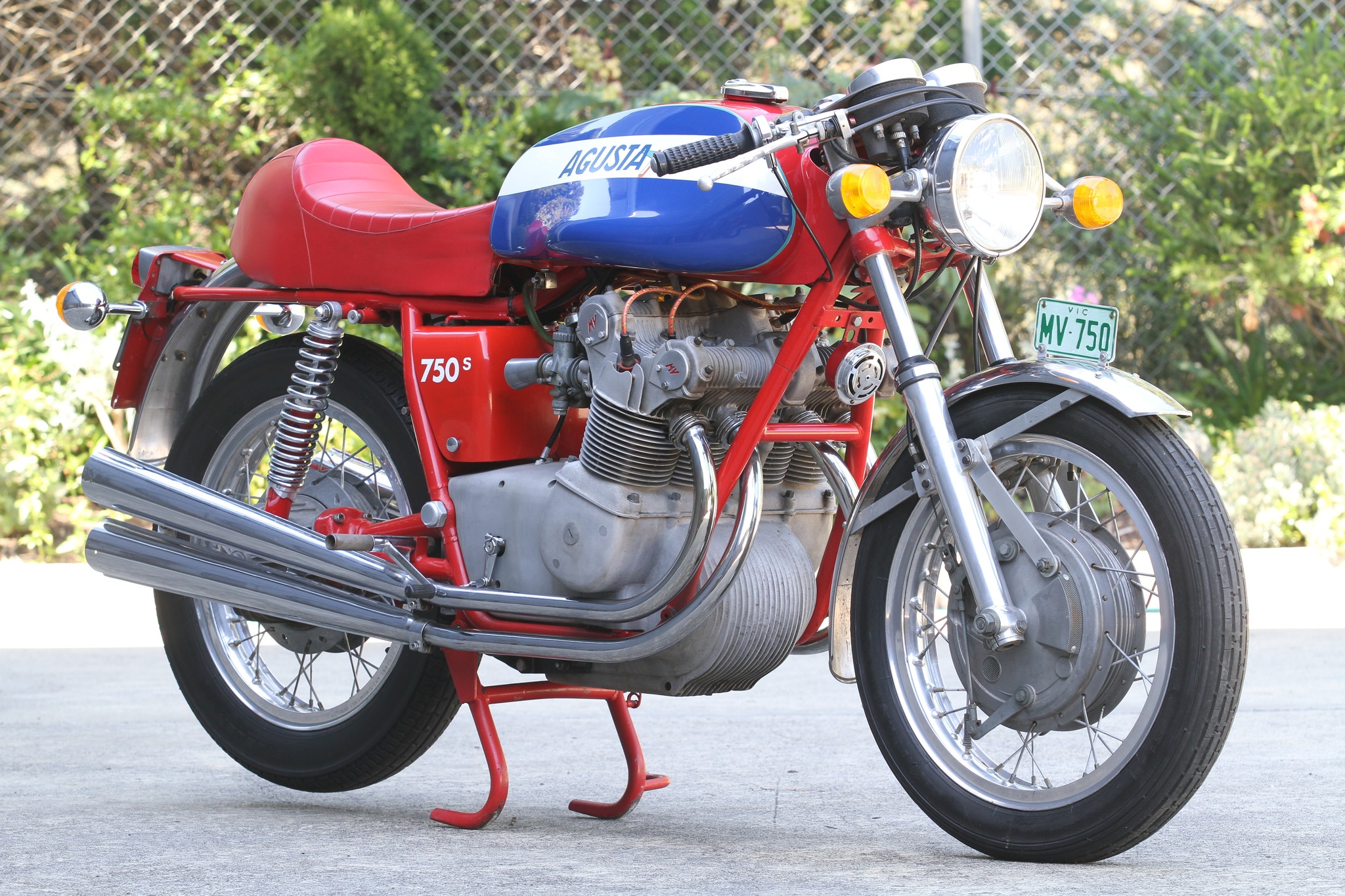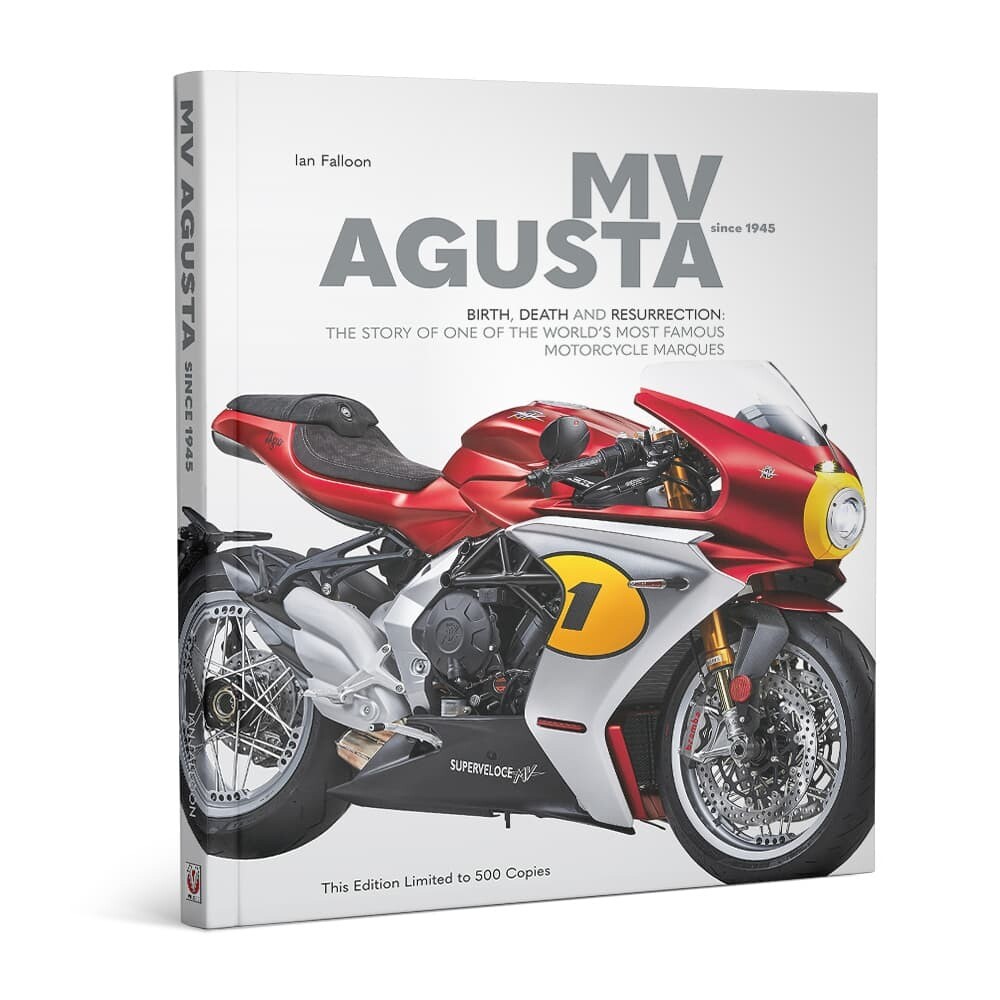Motorcycle Investor mag
Subscribe to our free email news
MV Agusta 750S
(by Ian Falloon, Feb 2022)

Falloon on the hallowed name of MV Agusta
There is no more hallowed name amongst the Italian motorcycle marques than that of MV Agusta. The testimony is in the total of 38 individual riders World Championships and 37 manufacturers World Championships over the twenty-five year period between 1952 and 1976. During that time MV’s won 270 World Championship races, an astonishing feat unlikely to be repeated ever again, and the spin-off from was a limited number of hand-built street bikes, headed by the magnificent 750 S.
The first four-cylinder MV Agusta street bike appeared in prototype form at the end of 1950, less than a year after the 500cc four-cylinder racer made its debut. In 1949 Count Agusta persuaded engine designer Piero Remor to leave Gilera and the new engine was virtually identical to the Gilera design. To appear different, and avoid legal liability, the first racing MV Agusta four incorporated shaft drive and torsion bar suspension, these features also appearing on the R19 Turismo road going prototype.
The R19 was never destined for production but by 1966 Honda posed a threat in 500cc Grand Prix racing and MV Agusta replaced their venerable four with a more compact triple. Rather than waste the production facility Count Agusta then decided to make the four available as an expensive limited edition street bike. This time it was a 600cc version of the same engine producing a claimed 52 horsepower at 9000rpm. Weighing 221kg and equipped with shaft final drive, the 600 was created as a touring machine so that customers wouldn't be tempted to convert it into a four-cylinder MV racer. The 600 was also extremely ugly, the front dominated by a large rectangular Fiat car headlamp.
Despite the rather unfortunate styling, the 600 was quite an innovative machine. Not only was it one of the first across the frame fours and also included an electric start and a pair of cable-operated Campagnolo twin front disc brakes. But such an idiosyncratic and expensive machine (every buyer was entitled to spend a week at the factory learning how to ride and service it) had a very limited market and in 1970 the more sporting 750 S replaced it. This time MV not only got the styling right, and despite the shaft drive the 750cc engine offered real performance.

The 750 S was essentially a bored (65x56mm) 600 but with its bright new colours and sculptured tank looked considerably more sporting. The engine, fundamentally the old 500cc Grand Prix four from the 1950’s, dominated the 750 S and while initially appearing massive and brutal, close-up the individual components had an intricate, almost delicate character. Inside it was a masterpiece of precision castings, gears, needle and ball bearings. A matched set of three straight-cut gears running between the interior cylinders drove the two double overhead camshafts, while the pressed together crankshaft ran in ball bearings and was held in a separate cylinder block sub-assembly bolted to the main engine casting. A carry-over from MV racing practice, this not only supported the crankshaft, but it also eliminated the need for complex and intricate casting/machining operations in such a limited production engine.
While other production four-cylinder engines hung the alternator and ignition points off the ends of the crankshaft, the widest part of the MV engine was the outer cylinders. An automotive style Bosch starter-generator fitted behind the engine sump with an automotive Bosch ignition of a contact-breaker and distributor. With four Dell’Orto UB24mm carburettors and a 10:1 compression ratio the power increased to 66 horsepower at 8000rpm.
The chassis was also improved over the 600, a massive 230mm Grimeca double drum brake on the front replacing the ineffective mechanical discs. The suspension included a 35mm Ceriani front fork and a pair of Sebac shock absorbers, while the wheels were 18-inch Borrani.
The wheelbase a short 1390mm, but with a dry weight of 235kg the 750 S was still very heavy, mostly due to the sand-cast engine crankcases and cylinder head (because of the small production runs) and the shaft final drive. The unsprung weight of the rear drive had a detrimental effect on handling, while the short wheelbase and top heavy feeling provided the 750 MV with unique handling.
As a result the MV fours never possessed the poise of other Italian race replicas and were not as successful in production racing. Sydney dealer Brian Clarkson entered a MV Agusta 750 S in the 1972 Castrol Six- Hour race, but retired before half-distance with clutch problems – the bike smoking heavily under acceleration just prior to retirement. Clarkson also rode the 750 S at Bathurst in 1973, finishing 6th in the Chesterfield 5000.
MV fours may be flawed and compromised in their execution, but the soul of these motorcycles is the wonderful engine. While providing a connection with a racing past, it also remains one of the most sophisticated, complicated and beautiful engines ever to grace a streetbike. No other motorcycle engine can replicate the sound and experience of a four-cylinder MV howling and one ride can forgive the foibles of a flawed chassis.

-------------------------------------------------
Produced by AllMoto abn 61 400 694 722
Privacy: we do not collect cookies or any other data.

Archives
Contact





